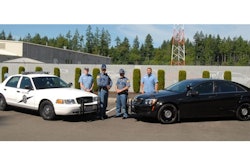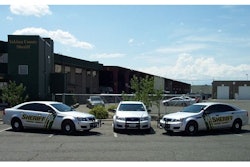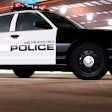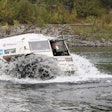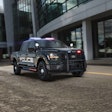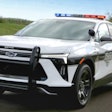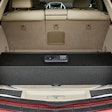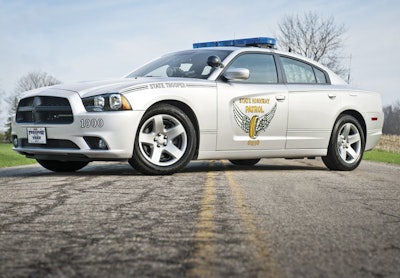 The Ohio State Highway Patrol's Dodge Charger Pursuit. Photo: OSHP
The Ohio State Highway Patrol's Dodge Charger Pursuit. Photo: OSHP
Editor's note: View our slideshow of in-service patrol cars.
The glitzy unveilings of the new patrol cars seem like a distant memory now. Engine and drive-train specifications have become accepted fact. Police evaluators in Michigan and California have logged performance data. Now the real test arrives for the crop of vehicles replacing the venerable Ford Crown Vic Police Interceptor: They are going to the patrol cops.
Agencies with fleet-replacement budgets have begun selecting the Chevrolet Caprice PPV, Dodge Charger Pursuit, Ford Police Interceptor sedan, and Ford P.I. Utility to patrol their jurisdictions. And the first wave of new-era patrol cars—with agency badging, logos, and color schemes—have reached the streets.
Not all law enforcement agencies are choosing from the crop of new cars. Some opted to stockpile Ford CVPIs in 2011—the vehicle's final production year—or shift to the pursuit-rated Chevrolet Tahoe SUV.
Picking a new patrol vehicle hasn't been a uniform process, and agencies gave a variety of reasons for their choice. In some cases, cost primarily motivated the purchase. Other agencies sought payload capacity, interior comfort, performance, or rear-end crash safety. In almost all cases, the choice grew out of the agency's mission and environmental conditions in the jurisdiction.
Consider the following case studies from these four early adopters who have issued the new patrol vehicles to their officers for road patrol.
Forsyth County, Ga., Sheriff Ted Paxton told his staff he had just one requirement for the agency's cruiser that would replace the Ford CVPI—it had to have rear-wheel drive. That narrowed the choices to the Chevrolet Caprice PPV and Dodge Charger. The agency ultimately went with the 355-horsepower V-8 Caprice, which delivers lights-out performance. The Caprice was the top performer when first tested by the Michigan State Police's Precision Driving Unit in 2010.
"I can tell you at high speeds, they hold the road very tight," says Capt. Tim House, the sheriff's commander of administrative services. "There’s not a lot of drift. For overall acceleration, the car is extremely fast."
So far, the sheriff's office has received 19 vehicles, including 14 that have been painted two-tone black and white. Another 16 were ordered Jan. 1. The agency now has about 230 marked patrol units in its fleet of 322 vehicles.
Once a vehicle is painted, the agency installs a Havis cage, Motorola radio system, Apex lightbar, Panasonic Toughbook mobile computer, and a Digital Safety Technologies’ DP2 in-car video system.
The Forsyth County Sheriff's Caprices patrol a jurisdiction in the foothills of the Appalachian Mountains about 45 minutes north of Atlanta in a mostly rural county of 175,000 residents. So far, the vehicles are averaging 10 to 12 miles per gallon in fuel consumption.
Other agencies that have chosen the Chevy Caprice PPV include the Aurora (Colo.) Police Department, Brunswick (Maine) Police Department, Cedar Rapids (Iowa) Police Department, Henderson (Ky.) Police Department, Kentucky State Police, Lowell (Mass.) Police Department, Montclair (Calif.) Police Department, Thomasville (Ala.) Police Department, Washington County (Ore.) Sheriff's Office, Washington State Patrol, and Yakima County (Wash.) Sheriff's Office.
Like the Forsyth County sheriff, the Ohio State Highway Patrol also wanted a rear-wheel drive patrol car and a V-8 engine to replace its fleet of aging Ford CVPIs.
Earlier this year, the agency issued the first batch of 2012 Dodge Chargers to road troopers for enforcement. So far, about 20 have been added to the agency's 1,200-vehicle marked fleet. The decision will keep the highway patrol from having to retrain its troopers to use a different type of drive train.
"The Ford CVPI is a rear-wheel-drive vehicle, and all of our people have been trained on rear-wheel-drive vehicles," says Lt. Anne Ralston, the patrol’s spokesperson. The rear-wheel drive train is "proven and reliable for law enforcement work," Ralston adds.
The agency also likes the Charger's cabin size and trunk space, which both exceeded those of the Ford CVPI. Vehicles are retired at 130,000 miles. The new Chargers were purchased for $22,737 each.
In recent years, the agency has shifted to silver from white for its marked units and replaced its traditional red-and-white lightbar with a blue-only LED lightbar. Supplemental red lighting is added to the front grill and rear of the vehicle.
In addition to the CVPI converts, some agencies that shifted to the Charger when it was first introduced in 2006 stayed with the vehicle after evaluating the Caprice and Ford interceptors. Belvidere (Ill.) Police Department Chief Jan Noble said his officers liked the legroom and headroom in the vehicle, as well as the outer appearance.
"We felt the vehicle projected the image of fair but firm enforcement," says Noble, who shifted from the Chevy Impala. "It just has a 'let's get up and go appearance.'"
The Charger has continued to improve since its 2005 model year, according to Oklahoma County, Okla., Sheriff John Wetzel. "Our mechanics have done work on Fords and Chevys," he says. "The Chargers have held up better than anyone ever expected."
Other agencies that have chosen the Dodge Charger Pursuit include the Albuquerque (N.M.) Police Department, Cape Coral (Fla.) Police Department, Hackettstown (N.J.) Police Department, Hazard (Ky.) Police Department, Kansas Highway Patrol, New Holstein (Wis.) Police Department, Orangeburg County (S.C.) Sheriff's Office, Randolph (Mass.) Police Department, and the Texas Department of Public Safety.[PAGEBREAK] The Marion County (Fla.) Sheriff's Office's Ford Police Interceptor sedan. Photo: MCSO
The Marion County (Fla.) Sheriff's Office's Ford Police Interceptor sedan. Photo: MCSO
While some agencies prioritize performance, others say fuel economy drove their purchase decision. The Marion County (Fla.) Sheriff's Office says that's one of the primary reasons that it chose to purchase 36 Ford Police Interceptor sedans with 3.5-liter EcoBoost V-6 engines and all-wheel drive. The sheriff’s office will receive four to five new Ford P.I. sedans each week to replace its aging Ford CVPIs.
"Although this engine boasts 365 horsepower, it is estimated to provide at least a 20% increase in our current fuel mileage," says Judge Cochran, the MCSO public information officer.
Cochran explains that this improved fuel economy could save the agency $500,000 a year once the entire fleet is upgraded to the new models. The county will equip the new vehicles with radios, computers, graphics, and other police equipment.
"While being able to keep all of the options that are available on the current Crown Victoria Interceptor models, the committee decided to add a few more options that are now available with the new Police Interceptors," Cochran says. "One option is a driver-side ballistic door panel. Another option ordered with the new vehicles is back-up sensors that will warn officers when they are near anything when the vehicle is in reverse."
Before committing to the purchase, the sheriff’s office tested the Ford models at a road course in Orlando in December.
"A SWAT member drove his current patrol vehicle and was able to fit all of his patrol and SWAT equipment in the new sedan with space to spare," Cochran says. "The vehicle they picked as the best for handling and performance was the Police Interceptor sedan. It was described as being a 'game-changer' by one of the deputies."
To pay for the vehicles, the County Commission earmarked $442,000 to replace patrol vehicles in the 2009-2010 fiscal year. For the 2010-2011 fiscal year, the sheriff received approval that returned funds, $2.15 million in the MSTU (Municipal Service Taxing Unit) budget and $702,515 in county-wide funds, would be earmarked for replacement vehicles. The $442,000 went to pay for 14 Ford P.I. sedans and two Ford P.I. Utility models. One of each vehicle type will be used for the sheriff's K-9 unit.
Other agencies planning to use the Ford P.I. sedan include the Chicago Police Department, Des Moines (Iowa) Police Department, New York Police Department, Virginia State Police, and Wisconsin State Patrol.
The Ford P.I. Utility's increased payload, 75-mph rear-crash rating, and lower-slung car platform have attracted plenty of state police agencies, including the Massachusetts State Police. The MSP, which was one of the first agencies nationwide to adopt Ford’s P.I. Utility, has issued several of the vehicles to troopers and plans to use it as the primary enforcement vehicle in a current fleet of 1,800 marked units.
"The rear-end crash rating is very important to us," says Sgt. Mark Caron, the MSP's fleet administrator. "We do have a lot of rear-end hits. That crash test makes us feel very comfortable."
Massachusetts troopers will be issued the all-wheel-drive Utility to replace the rear-wheel Ford CVPIs. The reason administration chose all-wheel drive is easy to understand: snow. The all-wheel drive will assist troopers in exiting highway off-ramps and cornering especially on the hilly roads in the western part of the state, Sgt. Caron says.
The agency chose the Utility over Ford's P.I. sedan mostly for its increased interior space, especially for transporting prisoners. So far, the Utility has been a hit with the troopers who drive it.
"They love it," Sgt. Caron says. "They like the handling capability, the cornering, the acceleration, and the space. You sit a little bit higher, so you get a little bit better field of vision."
The agency agreed to purchase the Ford P.I. Utility for about $30,000 per vehicle, and can also add sedans for about $28,000 under the agreed-upon contract. The vehicles are painted in the agency’s blue-and-and gray color scheme. The agency then equips the vehicles with a lightbar, cage, and consoles for the police equipment.
Due to budget constraints, Sgt. Caron is now replacing 15% to 20% of his fleet each year. Police fleet managers strive to replace a third of their fleet annually.
Other agencies that have chosen the Ford P.I. Utility include the California Highway Patrol, Collin County (Texas) Police Department, Pennsylvania State Police, and Texas DPS.
Greg Basich contributed to this article. Greg is the Web editor for POLICE Magazine's sister publication Government Fleet.
Related:








